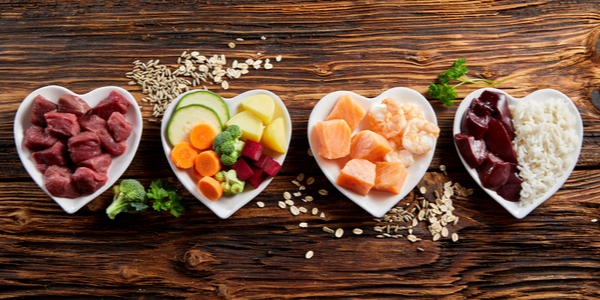4 Reasons Why Vets Recommend Homemade Dog Food Cooking – Top Dog Tips
Homemade dog food has become increasingly popular among pet owners. Many veterinarians approve this method as it allows for dog owners to be aware of every single ingredient being consumed by their dogs, keeping them safe and allowing easier diet monitoring.
On top of the recently concerning numbers of dog food recalls being issued due to dangerous components infiltrating supposedly safe and harmless foods, it’s little surprise that many pet owners feel the need to turn to homemade cooking to ensure the safety of their dogs. Here are the reasons many vets recommend homemade dog food cooking, and how to do it the right way. If you are here to find recipes find homemade dog recipes here.
Why Homemade Food Is Good For Dogs
1. Knowledge
Knowing exactly what goes into your dog’s food bowl is incredibly important to many pet owners. It gives them a sense of peace of mind and is especially helpful for those who need specialized diets or have very specific nutritional requirements that may be outside of the normal dog diet needs.
When you prepare all of your dog’s food from scratch, you know to the last detail just what is going into their mouths and passing through their digestive system, allowing you to better monitor their overall health and respond appropriately to adverse reactions to food. You can pick the right foods for them, provide the exact amounts of certain nutrients, and be sure that there are no suspicious additives – which brings us to our next point.
2. Dubious Commercial Dog Food
A lot of dog food products contain unspecified meats and meat by-products, and by definition, manufacturers are not required to specify just what kind of meat they are using. If a dog food pack is vague about the meat content of their food, there’s a chance it’s because the company doesn’t want you to really know what’s in it.
Plenty of dog foods use non-specified meat in their make, which means that they are legally allowed to contain what is known as 4D meat – or meat from diseased, disabled, dying, or dead animals. These kinds of meat can include slaughterhouse waste, expired meat from grocery stores, rancid oil or grease, and, in extreme cases, euthanized animals or even roadkill carcasses.

Not only do these types of meat have a higher chance of carrying diseases that could harm your pet, they are just not very pleasant to think about in general, and this provides a very good reason to avoid commercial pet food.
3. Preservatives
When something contains a lot of bad meat, it’s going to need preservatives in order to have a long shelf life so you can feed it to your pet months after purchasing it. But there’s a problem with that. Many preservatives have been linked to potential diseases, and when they are in dog food, a pup is essentially ingesting harmful substances.
Some of these include BHA, which can impair brain function and cause cell abnormalities and cancer, BHT, which is also carcinogenic and can damage the nervous and respiratory systems, and ethoxyquin, which is literally marked as a poisonous substance.
4. Cost
In order to ensure your dog gets the best care, you will likely be willing to pull out all the stops to provide them with the food and products they need, even at a high expense. But choosing to home cook your pup’s meals could cut food prices in half!
The average cost of feeding a medium-sized dog two healthily sized meals a day with commercial pet food will likely amount to around US$5. This is assuming you mix one can of wet food with a cup of dry food at every meal.
On the other hand, using a similar quantity of homemade food of the same quality as commercial foods will likely cost you just about US$2.25 daily. This even adds in the possible cost of supplements, such as vitamin, mineral, and calcium supplements. This means cooking food at home for your dog is much cheaper than buying it!
What To Include In A Homemade Diet
It is incredibly crucial that, if you choose to feed your dog a homemade diet, you are ensuring that they get all the necessary nutrients and components they need in order to live a healthy life with a strong body.
It can be somewhat complex to ensure this when you are home cooking dog food. Most commercial dog foods are designed to already include most of the nutrients a pup needs, meaning pet owners who use store-bought food never really have to worry that their pups aren’t getting enough.

If you aren’t educated in the correct proportions of food to give to your dog when homemaking their food, you may wind up doing drastically negative things to your dog’s overall health. This is why educating yourself is so important before you embark on the homemade pet food journey. Here is a list of the nutritional components necessary in a dog’s diet”
Protein
All body tissues are built from proteins, but a pup’s body only naturally creates 13 of the needed 23 amino acids to build these proteins. As such, the remaining 10 need to come from a protein-rich diet.
Fats
Healthy fats provide energy to a dog and boost skin and fur health. You will especially want to make sure fatty acids, like omega-3 and omega-6, are included in your dog’s diet.
Carbohydrates
Carbs provide energy to a dog and the amount you give depends mostly on how active your pup is. High-quality sources of carbohydrates will also offer moderately fermentable fibers that increase the function of the gut and digestive system healthily.
Vitamins and Minerals
These help to regulate the chemical reactions that have to take place in a dog’s body, such as the strengthening of bones and other necessary building processes. While dogs do naturally produce vitamin C, they do need vitamins A, B, D, E, and K, and they will also need a good amount of phosphorus and calcium.
Do note that many homemade dog diets may run the risk of neglecting certain nutritional groups, leaving a pup lacking in important nutrition. This may result in the need for supplements or more varied meal plans. It’s recommended that you speak to your vet about the exact percentages to include from each food group, as all dogs have differing needs. Do note that you should always discuss your options with a vet before starting your dog on any new diet or supplement.




